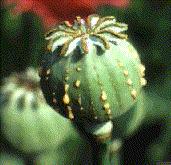


1.
The whole explanation
[from www.encyclopedia.cm]
Opium
Substance derived by collecting and drying the milky juice in the unripe seed pods of the opium poppy , Papaver somniferum. Opium varies in color from yellow to dark brown and has a characteristic odor and a bitter taste. Its chief active principle is the alkaloid morphine , a narcotic . Other constituents are the alkaloids codeine, papaverine, and noscapine (narcotine); heroin is synthesized from morphine. Morphine, heroin, and codeine are addicting drugs; papaverine and narcotine are not. A tincture of opium is called laudanum ; paregoric is a mixture of opium, alcohol, and camphor.
Opium - history
The
medicinal properties of opium have been known from the earliest times, and it
was used as a narcotic in Sumerian and European cultures at least as early as
4000 BC The drug was introduced into India by the Muslims and its use spread to
China. Early in the 19th cent., against Chinese prohibitions, British merchants
began smuggling opium into China in order to balance their purchases of tea for
export to Britain, an act that set the stage for the Opium Wars . Chinese
emigrants to the United States, who were employed to build the transcontinental
railroad, brought the opium-smoking habit to the West Coast.
During the 19th cent. opium was grown in the United States as
well as imported. Besides indiscriminate medical use, opiates were available in
the United States in myriad tonics and patent medicines, and smoking in opium
dens was unhindered, resulting in an epidemic of opiate addiction by the late
1800s. The generous use of morphine in treating wounded soldiers during the
Civil War also produced many addicts.
Importation of opium by Chinese nationals was prohibited in
1887; in 1906 the Pure Food and Drug Act required accurate labeling of patent
medicines. The Harrison Narcotics Act of 1914 taxed and regulated the sale of
narcotics and prohibited giving maintenance doses to addicts who made no effort
to recover, leading to the arrest of some physicians and the closing of
maintenance-treatment clinics. Since then, numerous laws attempting to regulate
importation, availability, use, and treatment have been passed, and the concern
with opium addiction per se has largely been replaced by concern with heroin,
cocaine , marijuana , and other illegal drugs.
Large quantities of opium are still grown, some for
legitimate use, on opium poppy farms in Southeast Asia (the “Golden
Triangle:” primarily in Myanmar), Southwest Asia (primarily Afghanistan and
Pakistan), and Latin America (primarily Colombia). The opium gum may be crudely
refined and smoked (e.g., “brown sugar” ) or converted to morphine and
heroin. Growers usually make more for opium than for other crops, and the
cultivation and refining employ hundreds of thousands of people, but the real
profits go to the drug traffickers. It is estimated that the street price for
heroin is 153 to 183 times that of the opium bought from the farmer. Despite
laws and agreements to control its use, a worldwide illicit opium traffic
persists